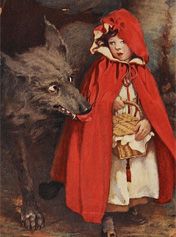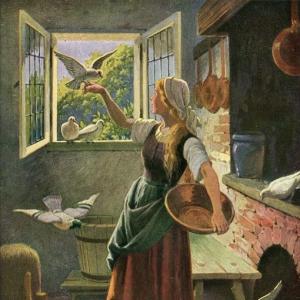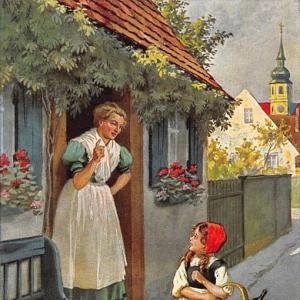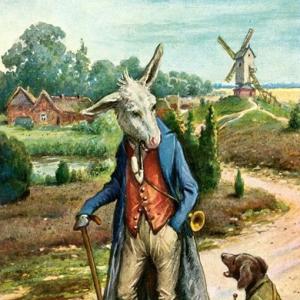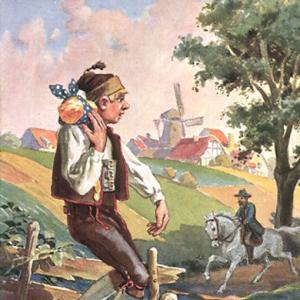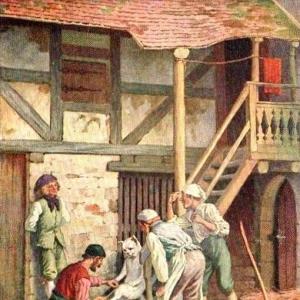Reading time for children: 4 min
The she-wolf brought forth a young one, and invited the fox to be godfather. „After all, he is a near relative of ours,“ said she, „he has a good understanding, and much talent. He can instruct my little son, and help him forward in the world.“ The fox, too, appeared quite honest, and said, „Worthy Mrs. Gossip, I thank you for the honour which you are doing me. I will, however, conduct myself in such a way that you shall be repaid for it.“ He enjoyed himself at the feast, and made merry; afterwards he said, „Dear Mrs. Gossip, it is our duty to take care of the child, it must have good food that it may be strong. I know a sheep-fold from which we might fetch a nice morsel.“ The wolf was pleased with the ditty, and she went out with the fox to the farm-yard. He pointed out the fold from afar, and said, „You will be able to creep in there without being seen, and in the meantime I will look about on the other side to see if I can pick up a chicken.“ He, however, did not go there, but sat down at the entrance to the forest, stretched his legs and rested. The she-wolf crept into the stable. A dog was lying there, and it made such a noise that the peasants came running out, caught Gossip Wolf, and poured a strong burning mixture, which had been prepared for washing, over her skin. At last she escaped, and dragged herself outside. There lay the fox, who pretended to be full of complaints, and said, „Ah, dear Mistress Gossip, how ill I have fared, the peasants have fallen on me, and have broken every limb I have. If you do not want me to lie where I am and perish, you must carry me away.“ The she-wolf herself was only able to go away slowly, but she was in such concern about the fox that she took him on her back, and slowly carried him perfectly safe and sound to her house. Then the fox cried to her, „Farewell, dear Mistress Gossip, may the roasting you have had do you good,“ laughed heartily at her, and bounded off.
 Learn languages. Double-tap on a word.Learn languages in context with Childstories.org and Deepl.com.
Learn languages. Double-tap on a word.Learn languages in context with Childstories.org and Deepl.com.Backgrounds
Interpretations
Adaptions
Summary
Linguistics
„Gossip Wolf and the Fox“ is a lesser-known fairy tale collected by the Brothers Grimm, Jacob and Wilhelm Grimm, who were German scholars, cultural researchers, and authors. They are best known for their collection of German and European folk tales, which were first published in the early 19th century as „Children’s and Household Tales“ (Kinder- und Hausmärchen in German).
The Brothers Grimm collected and compiled these tales as part of a broader movement to preserve and document the oral tradition and cultural heritage of Germany and Europe. Their work helped establish the study of folklore as a legitimate academic discipline. The fairy tales they collected have become some of the most famous and enduring stories in the Western literary canon, with many being adapted into various forms of media, including film, television, and theater.
„Gossip Wolf and the Fox,“ like many other Grimm fairy tales, often features talking animals and teaches moral lessons. This particular story revolves around the cunning fox and the naive she-wolf, exploring themes of trust, deception, and discernment. The tale serves as a cautionary reminder for readers to be careful about whom they trust, as appearances and familial ties can sometimes be deceiving.
It is essential to note that the Brothers Grimm’s collection of fairy tales underwent multiple revisions and editions, resulting in variations in the stories. Some of these revisions were made to make the stories more suitable for children, as the original versions often contained darker themes and explicit content.
There are several interpretations that can be drawn from the Brothers Grimm’s „Gossip Wolf and the Fox“ fairy tale:
Deception and cunning: The tale highlights the deceptive nature of the fox, who tricks the she-wolf into believing that he genuinely cares for her and her child. The fox’s cunning behavior serves as a warning to be cautious about whom we trust and the intentions of those around us.
Exploitation of trust: The she-wolf trusts the fox due to their family ties and his apparent wisdom. However, the fox takes advantage of her trust for his own amusement, teaching readers that even close relatives or friends can sometimes betray our trust.
Consequences of naivety: The she-wolf’s willingness to believe the fox’s lies and act on his suggestions demonstrates her naivety. This story illustrates the potential dangers of being overly trusting and failing to question the motives of others.
The importance of discernment: The tale serves as a reminder to practice discernment when dealing with others, especially when their intentions are not clear. It is crucial to be vigilant and make informed decisions to avoid being deceived or taken advantage of.
The value of self-reliance: The she-wolf depends on the fox to help her and her child, instead of relying on her own instincts and abilities. The story demonstrates the importance of self-reliance and developing one’s own skills to face life’s challenges.
Overall, „Gossip Wolf and the Fox“ teaches valuable lessons about trust, deception, discernment, and self-reliance. It serves as a cautionary tale to remind readers to be vigilant and wise when dealing with others, as not everyone may have their best interests at heart.
The fairy tale „Gossip Wolf and the Fox“ from Brothers Grimm has been adapted and retold in various forms over the years. Here are some notable adaptations:
„The Fox and the Wolf“ by Aesop: Aesop’s fable „The Fox and the Wolf“ is similar to the Brothers Grimm tale, with the fox outwitting the wolf in a contest of cunning.
„The Fox and the Crow“ by Jean de La Fontaine: This French fable is similar to „Gossip Wolf and the Fox“, with the fox using flattery to trick a crow into dropping a piece of cheese.
„The Tortoise and the Hare“ by Aesop: This famous fable also emphasizes the importance of perseverance and honesty over intelligence and cunning.
„The Tale of Jemima Puddle-Duck“ by Beatrix Potter: This children’s book features a similar plot, with a fox attempting to trick a duck, but ultimately being foiled by a wise friend.
„Reynard the Fox“: This medieval Dutch epic features Reynard the Fox, a trickster character who often outwits his animal friends and enemies in various contests of cunning.
„The Crow and the Fox“ by Leo Lionni: This children’s book is a retelling of the fable „The Fox and the Crow“, with illustrations that emphasize the moral of the story.
„The Gingerbread Man“: This classic children’s story features a similar plot, with a cunning fox attempting to trick a gingerbread man into becoming his lunch.
These adaptations and retellings showcase the enduring popularity of the themes and lessons found in „Gossip Wolf and the Fox“.
In the Brothers Grimm fairy tale „Gossip Wolf and the Fox,“ a she-wolf gives birth to a young wolf and asks the fox, a clever and talented relative, to be the godfather. The fox accepts the invitation graciously, promising to help raise and guide the young wolf. At the feast, the fox suggests they get good food for the child, pointing out a sheep-fold on a nearby farm.
The she-wolf and fox venture to the farm together, but instead of helping, the fox sits down near the forest entrance to rest. As the she-wolf sneaks into the stable, a dog’s barking alerts the peasants, who catch the she-wolf and pour a burning mixture on her skin. The wounded she-wolf manages to escape and finds the fox pretending to be injured, claiming the peasants hurt him too. The sympathetic she-wolf, struggling herself, carries the fox on her back to her home.
Upon reaching the house, the fox reveals that he was never injured, mocks the she-wolf’s misfortune, and leaves her, laughing and bounding away. The story highlights the cunning and deceptive nature of the fox, who takes advantage of the she-wolf’s trust and concern for his own amusement.
The fairy tale „Gossip Wolf and the Fox“ by the Brothers Grimm offers a rich tapestry for linguistic analysis, shedding light on thematic elements, character dynamics, and socio-cultural implications inherent in the story.
Characterization through language: The language used to describe the fox is cunning and manipulative. Phrases like „conduct myself in such a way that you shall be repaid for it“ and his polite thanking of Mrs. Gossip demonstrate his deceitful nature cloaked in courteous speech. The she-wolf’s language is trusting and somewhat naive, evident through her willingness to accept the fox’s suggestion without skepticism.
Dialogue and social roles: Formal and courteous dialogue is used to establish social roles and relationships, especially in how the animals address each other with respectful titles like „Worthy Mrs. Gossip. “
– The fox’s use of the phrase „Dear Mrs. Gossip, it is our duty to take care of the child“ leverages social obligation and duty as a means to manipulate the she-wolf.
Idiomatic expressions and euphemisms: The fox’s farewell, „may the roasting you have had do you good,“ uses sarcasm and euphemism to highlight his trickery and the betrayal, camouflaging the severity of the harm caused with a mocking benediction.
Symbolism and thematic elements: Themes of trust and betrayal are emphasized through the linguistic contrast between the sincere, trusting language of the she-wolf and the duplicitous, self-serving language of the fox. The story uses language to reinforce the moral lesson about the dangers of naivety and blind trust, especially towards those who appear well-intentioned but are inherently selfish.
Irony and humor: There’s situational irony in the wolf’s plight versus the fox’s expectation, and dramatic irony in the fox’s feigned injuries because the audience is aware of his deception. The humor derives from the fox’s audacity and the absurdity of the situation, showcasing traditional folkloric humor that often underlines serious moral lessons.
Overall, the linguistic elements of „Gossip Wolf and the Fox“ serve to effectively convey character intentions, moral lessons, and cultural values, illustrating the complexities of trust and deception within social relationships.
Information for scientific analysis
Fairy tale statistics | Value |
|---|---|
| Number | KHM 74 |
| Aarne-Thompson-Uther-Index | ATU Typ 152A |
| Translations | DE, EN, DA, ES, PT, IT, JA, NL, PL, RU, TR, VI, ZH |
| Readability Index by Björnsson | 31.8 |
| Flesch-Reading-Ease Index | 81 |
| Flesch–Kincaid Grade-Level | 6.9 |
| Gunning Fog Index | 9.1 |
| Coleman–Liau Index | 7.2 |
| SMOG Index | 7.8 |
| Automated Readability Index | 7 |
| Character Count | 1.947 |
| Letter Count | 1.483 |
| Sentence Count | 19 |
| Word Count | 379 |
| Average Words per Sentence | 19,95 |
| Words with more than 6 letters | 45 |
| Percentage of long words | 11.9% |
| Number of Syllables | 473 |
| Average Syllables per Word | 1,25 |
| Words with three Syllables | 12 |
| Percentage Words with three Syllables | 3.2% |




